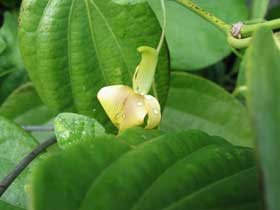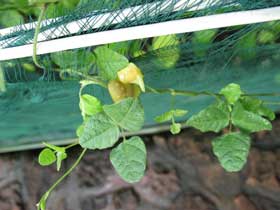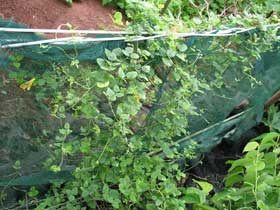Vigna o-wahuensis
Genus
Vigna
Species
o-wahuensis
Common Names
- Oʻahu cowpea
- Oʻahu vigna
Synonyms
- Vigna owahuensis
- Vigna sandwicensis
Names with Unknown Sources
- Nanea
Distribution Status
Endemic
Endangered Species Status
Federally Listed
Plant Form / Growth Habit
- Non-Woody, Spreading
Mature Size, Height (in feet)
- Herbaceous, Short, Less than 1
- Herbaceous, Medium, 1-3
- Herbaceous, Tall, Greater than 3
Mature Size, Width
This is a vine that grows to approximately 4 to 16 inches long. The above "Mature Size" is based on its vining nature.
Life Span
Short lived (Less than 5 years)
Landscape Uses
- Container
- Ground Cover
- Trellis or Fence Climber
Additional Landscape Use Information
These rare native vines can be annual or perennial, but are best grown as an annual since they are easy to grow and spread rapidly. They grow well on wire or wood fencing, on shrubs, and even up into trees that provide enough sunlight. An easy to grow vine if pests such as red spider mite can be kept under control.
Due their nature of broadcasting seeds (dehiscent) from the pod, they often appear in the oddest places, such as a crack in the sidewalk, on a rock wall, in an open pipe, or some other debris-filled crevice! Because of the dehiscent force, you may hear the seeds hit objects such as the siding on the house or a metal object in the area. So be sure to collect the seed pod turn brown and woody before this blessed event happens. [David Eickhoff, Native Plants Hawaiʻi]
Source of Fragrance
- No Fragrance
Plant Produces Flowers
Yes
Flower Type
Not Showy
Flower Colors
- Green
- Yellow
Additional Flower Color Information
Oʻahu vigna has clusters of one to four thin translucent pale yellow or greenish yellow flowers.
Blooming Period
- Sporadic
Additional Blooming Period and Fruiting Information
Oʻahu vigna is an annual or perennial. The ripe brown furry seed pods are dehiscent ...that means they are explosive! and can broadcast seeds several feet away throughout the yard or landscape. As mentioned, seedlings will appear in rainy weather or when the area is watered, sometimes in cracks in rock walls or concreted areas. [David Eickhoff, Native Plants Hawaiʻi]
Plant texture
- Fine
- Medium
Additional Plant Texture Information
Leaves are up to 3 inches long and are sparsely or moderately covered with course hairs. [2] There is much variation in leaf shape, size and texture among this species.
Leaf Colors
- Light Green
- Medium Green
Additional Pest & Disease Information
These vines are often attacked by both spider mites and leaf miners. [David Eickhoff, Native Plants Hawaiʻi]
Slugs can also be a problem. [Rick Barboza, Hui Kū Maoli Ola]
Fertilizer
These nitrogen-fixing vines require no additional nitrogen in fertilizer. Foliar feeding monthly in early morning with a water-soluble or an organic fertilizer (e.g. kelp or fish emulsion) at one-third to one-fourth the recommended strength has proved beneficial. [David Eickhoff, Native Plants Hawaiʻi]
Pruning Information
Unless plant is vining into unwanted areas, pruning is not necessary. After the plants flower, collect ripe seed pods before the burst, and remove dead vines if needed. [David Eickhoff, Native Plants Hawaiʻi]
Water Requirements
- Dry
Additional Water Information
After the plant is established, water weekly if the weather is dry.
Soil must be well drained
Yes
Light Conditions
- Full sun
- Partial sun
Additional Lighting Information
For optimal results, it should be planted in full sunlight.
Spacing Information
Plant every 1 to 3 feet apart. The vines will grow together. Seeds planted on location often may offer better results than transplanting the vines. [David Eickhoff, Native Plants Hawaiʻi]
Tolerances
- Drought
- Wind
- Heat
Soils
- Cinder
- Organic
Special Growing Needs
Plants should be provided with other shrubs, a trellis, or a fence to climb on.
Natural Range
- Niʻihau
- Oʻahu
- Molokaʻi
- Lānaʻi
- Maui
- Kahoʻolawe
- Hawaiʻi
Natural Zones (Elevation in feet, Rainfall in inches)
- Less than 150, 0 to 50 (Dry)
- 150 to 1000, 0 to 50 (Dry)
- 1000 to 1999, 0 to 50 (Dry)
- 2000 to 2999, 0 to 50 (Dry)
- 3000 to 3999, 0 to 50 (Dry)
- 4000 to 4999, 0 to 50 (Dry)
Additional Habitat Information
A very rare and seldom seen vine known to grow primarily in dry grassland and shrubland from 30 to about 4500 feet.
It is presumed to be naturally extinct on Niʻihau and Oʻahu, which is ironic given the common name Oʻahu vigna and Latin species name o-wahuensis, an older written form of Oʻahu [O-Wahu].
![]() Special Features and Information
Special Features and Information
General Information
Oʻahu vigna (Vigna o-wahuensis) is one of three Vigna species or Cow peas native to the Hawaiian Islands and a member of the Pea family or Fabaceae. This the only endemic species and federally listed as endangered.
There are, or were, two other indigenous species native to Hawaiʻi: the extant, that is still existing, nanea or mohihihi (Vigna marina), and wild pea (V. adenantha) now apparently extinct in the Hawaiian Islands, but existing elsewhere in the Pantropics.
Several closely related vigna species are grown for food worldwide. Among them are shōzu or azuki bean (Vigna angularis), urad bean or black gram (V. mungo), rice bean (V. umbellata), mung bean (V. radiata), Chinese long bean (V. unguiculata subsp. sesquipedalis) and black-eyed pea (V. unguiculata subsp. dekindtiana). [3]
Etymology
The generic name Vigna is named in honor of Dominico Vigna (?-1647), doctor, horticulturalist and professor of botany at the University of Pisa, Italy.
The specific epithet o-wahuensis has reference to an old spelling version for the island of Oʻahu [O-Wahu].
Background Information
Common names currently used for this wonderful species are Oʻahu vigna or Oʻahu cowpea. [1,2]
Early Hawaiian Use
Early Hawaiians were very aware of the plants and animals around them and most certainly knew of this species. But no Hawaiian name is yet known for this delicate endemic vine.
Additional References
[1] "Flora Hawaiiensis" by Otto Degener, Family: 169c Vigna Owahuensis
[2] "Recovery Plan for Multi-Island Plants" by USFWS, pages 1, 158, 159.
[3] http://en.wikipedia.org/wiki/Vigna [accessed 10/10/08]
PHOTOS FOR THIS SPECIES CAN BE SEEN AT THE LINK (Copy & Paste to your browser):
https://www.flickr.com/search/?user_id=50823119%40N08&sort=date-taken-desc&view_all=1&text=Vigna%20o-wahuensis
Plant Gallery
Back to Plant List
Other Nursery Profiles for Vigna o-wahuensis



